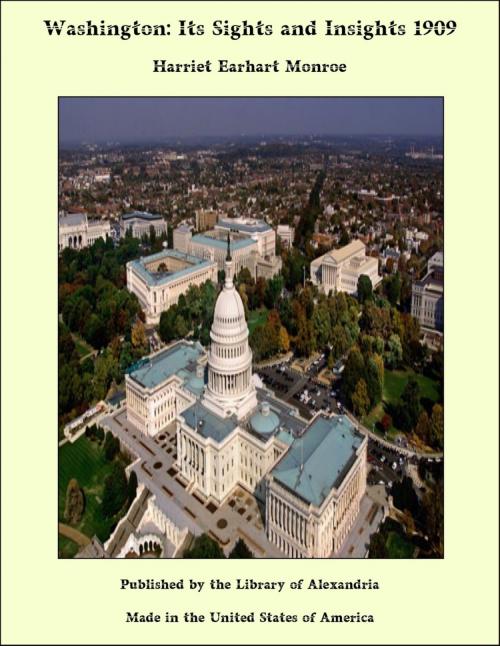Washington: Its Sights and Insights 1909
Nonfiction, Religion & Spirituality, New Age, History, Fiction & Literature| Author: | Harriet Earhart Monroe | ISBN: | 9781465610324 |
| Publisher: | Library of Alexandria | Publication: | March 8, 2015 |
| Imprint: | Language: | English |
| Author: | Harriet Earhart Monroe |
| ISBN: | 9781465610324 |
| Publisher: | Library of Alexandria |
| Publication: | March 8, 2015 |
| Imprint: | |
| Language: | English |
Washington himself desired the new city planned somewhat like Philadelphia, a plain checkerboard, but L'Enfant, while making the checkerboard style the basis, diversified, beautified, and complicated the whole by a system of avenues radiating from the Capitol as the centre and starting-point of the whole system. The streets running east and west are designated by letters. They are divided into two classes or sets—those north of the Capitol and those south of it. Thus, the first street north of the Capitol is A Street North, and the first street south of it is A Street South, the next is B Street, North or South, as the case may be, and so on. These distinctions of North, South, East, and West are most important, as forgetfulness of them is apt to lead to very great inconvenience. The streets are laid off at regular distances from each other, but for convenience other thoroughfares not laid down in the original plan have been cut through some of the blocks. These are called "half streets," as they occur between, and are parallel with, the numbered streets. Thus, Four-and-a-half Street is between Fourth and Fifth streets, and runs parallel with them. The avenues run diagonally across the city. New Jersey, Pennsylvania, Maryland, and Delaware avenues intersect at the Capitol, and Pennsylvania, New York, Vermont, and Connecticut avenues intersect at the President's house. Pennsylvania Avenue is the main thoroughfare. It is one hundred and sixty feet wide, and extends the entire length of the city, from the Eastern Branch to Rock Creek, which latter stream separates Washington from Georgetown. It was originally a swampy thicket. The bushes were cut away to the desired width soon after the city was laid off, but few persons cared to settle in the swamp. Through the exertions of President Jefferson, it was planted with four rows of fine Lombardy poplars—one on each side and two in the middle—with the hope of making it equal to the famous Unter den Linden, in Berlin. The poplars did not grow as well as was hoped, however, and when the avenue was graded and paved by order of Congress in 1832 and 1833 these trees were removed. Pennsylvania Avenue is handsomely built up, and contains some buildings that would do credit to any city. The distance from the Capitol to the President's house is one mile, and the view from either point along the avenue is very fine. Every circle, triangle, and square dedicated to monuments bears testimony to the taste of the original design. So little respect, however, was held for Major L'Enfant's plans that Daniel Carroll, one of the original owners of the land, was in the act of building a handsome house right across New Jersey Avenue. L'Enfant ordered it torn down. This was done, much to the disgust of Carroll and to the indignation of the commissioners. The government rebuilt the house for Carroll, but was careful to place it in a more suitable location. The old Duddington House, on Capitol Hill, was long a landmark of the early Washington architecture.
Washington himself desired the new city planned somewhat like Philadelphia, a plain checkerboard, but L'Enfant, while making the checkerboard style the basis, diversified, beautified, and complicated the whole by a system of avenues radiating from the Capitol as the centre and starting-point of the whole system. The streets running east and west are designated by letters. They are divided into two classes or sets—those north of the Capitol and those south of it. Thus, the first street north of the Capitol is A Street North, and the first street south of it is A Street South, the next is B Street, North or South, as the case may be, and so on. These distinctions of North, South, East, and West are most important, as forgetfulness of them is apt to lead to very great inconvenience. The streets are laid off at regular distances from each other, but for convenience other thoroughfares not laid down in the original plan have been cut through some of the blocks. These are called "half streets," as they occur between, and are parallel with, the numbered streets. Thus, Four-and-a-half Street is between Fourth and Fifth streets, and runs parallel with them. The avenues run diagonally across the city. New Jersey, Pennsylvania, Maryland, and Delaware avenues intersect at the Capitol, and Pennsylvania, New York, Vermont, and Connecticut avenues intersect at the President's house. Pennsylvania Avenue is the main thoroughfare. It is one hundred and sixty feet wide, and extends the entire length of the city, from the Eastern Branch to Rock Creek, which latter stream separates Washington from Georgetown. It was originally a swampy thicket. The bushes were cut away to the desired width soon after the city was laid off, but few persons cared to settle in the swamp. Through the exertions of President Jefferson, it was planted with four rows of fine Lombardy poplars—one on each side and two in the middle—with the hope of making it equal to the famous Unter den Linden, in Berlin. The poplars did not grow as well as was hoped, however, and when the avenue was graded and paved by order of Congress in 1832 and 1833 these trees were removed. Pennsylvania Avenue is handsomely built up, and contains some buildings that would do credit to any city. The distance from the Capitol to the President's house is one mile, and the view from either point along the avenue is very fine. Every circle, triangle, and square dedicated to monuments bears testimony to the taste of the original design. So little respect, however, was held for Major L'Enfant's plans that Daniel Carroll, one of the original owners of the land, was in the act of building a handsome house right across New Jersey Avenue. L'Enfant ordered it torn down. This was done, much to the disgust of Carroll and to the indignation of the commissioners. The government rebuilt the house for Carroll, but was careful to place it in a more suitable location. The old Duddington House, on Capitol Hill, was long a landmark of the early Washington architecture.















